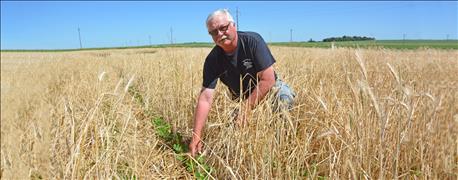July 26, 2016

Bill Nelson has managed to do something pretty incredible. He’s increased the average soil organic matter on his farm from about 1.9% 30 years ago to about 6.5% today.
His parents — careful stewards of the soil when they were actively farming — had rented out the farm for 15 years before Bill bought it in 1989.
After farming conventionally for a couple years, Nelson began no-tilling, adding small grains and alfalfa to the rotation, and planting cover crops. Now his farm near Madison, S.D., is a showcase for how soil health cane be improved.
Related story: "Return to 6.5% organic matter."
His top 10 tips for boosting soil health are:

NO-TILL IMPACT: Bill Nelson pulls back the rye straw to show the soybeans growing through the straw. Nelson used no-till and cover crops, such as the rye, to boost the biological life in the soil, which in turn increased the organic matter levels over time.
1. Talk to your family about the importance of soil health and explain your objectives.
2. Do your homework to learn about soil health management techniques — i.e. crop rotation, cover crops, no-till, etc.
3. Develop a soil health management plan with the help of the Natural Resources Conservation Service.
4. Set a goal for the amount of soil organic matter you’d like to achieve.
5. Try no-till. Start with a few acres. Wait until the soil conditions are right where no-till may work. Hire someone in the neighborhood who owns a no-till drill or planter to put in your crop so you don’t have to buy a planter and make a big commitment right away. Bill Nelson started to no-till on 40 acres and then converted the rest of his farm over a period of six years. “You are not going to see results from no-till overnight. I started seeing an improvement in organic matter in about six years on the place. The soil tilth dramatically increased.”
6. Implement nonchemical weed control where possible by adding cover crops to your rotation.

GROWING STRONG: Bill Nelson, kneeling in a no-till soybean field that had a rye cover crop on it, holds up a soybean seedling. The combination of no-till, cover crops and a diverse rotation is helping Nelson increase his soil’s organic matter to a level similar to native prairie.
7. When corn or bean prices are predicted to be low, or when you are headed for a dry spring, be flexible. Look for a cover or specialty crop beneficial to your crop rotation, which will maximize your profit potential.
8. Scout your fields to check for the presence of weeds, plant health and general field conditions.
9. Keep good records and write down notes so you can evaluate your progress.
10. Don’t give up after a year. Go into it with a minimum of a three-year commitment. You should begin to see improvement by then.
Source: South Dakota NRCS
You May Also Like




